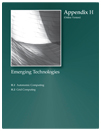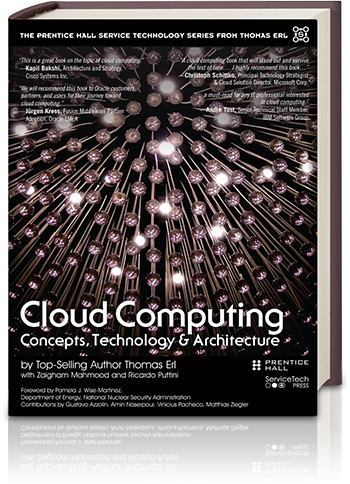This book begins with Chapters 1 and 2 providing introductory content and case study background information respectively. Provided here is a brief overview of subsequent chapters.
– Part I: Fundamental Cloud Computing
– Part II: Cloud Computing Mechanisms
– Part III: Cloud Computing Architecture
– Part IV: Working with Clouds
– Part V: Appendices
Below are descriptions of individual parts and chapters:
Chapter 1: Introduction
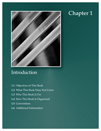 This chapter establishes the scope and structure of the book by providing an overview of the primary topic areas along with chapter descriptions and information regarding conventions and supplemental resources.
This chapter establishes the scope and structure of the book by providing an overview of the primary topic areas along with chapter descriptions and information regarding conventions and supplemental resources.
Chapter 2: Case Study Background
 The chapters in this book contain numerous case study examples, all of which relate back to the case study background information established in this chapter. Appendix A concludes the case study storylines with a brief summary.
The chapters in this book contain numerous case study examples, all of which relate back to the case study background information established in this chapter. Appendix A concludes the case study storylines with a brief summary.
Part I: Fundamental Cloud Computing
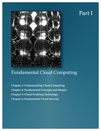
The four chapters in this part cover introductory topics in preparation for all subsequent chapters. Note that Chapters 3 and 4 do not contain case study content.
Chapter 3: Understanding Cloud Computing
Chapter 4: Fundamental Concepts and Models
Chapter 5: Cloud-Enabling Technology
Chapter 6: Fundamental Cloud Security
Chapter 3: Understanding Cloud Computing
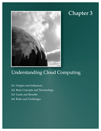
Following a brief history of cloud computing and a discussion of business drivers and technology innovations, basic terminology and concepts are introduced, along with descriptions of common benefits and challenges of cloud computing adoption.
Chapter 4: Fundamental Concepts and Models
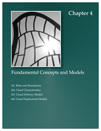 Cloud delivery and cloud deployment models are discussed in detail, following sections that establish common cloud characteristics and roles and boundaries.
Cloud delivery and cloud deployment models are discussed in detail, following sections that establish common cloud characteristics and roles and boundaries.
Chapter 5: Cloud-Enabling Technology
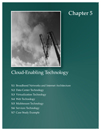 Contemporary technologies that realize modern-day cloud computing platforms and innovations are discussed, including data centers, virtualization, and Web-based technologies.
Contemporary technologies that realize modern-day cloud computing platforms and innovations are discussed, including data centers, virtualization, and Web-based technologies.
Chapter 6: Fundamental Cloud Security
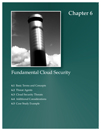 Security topics and concepts relevant and distinct to cloud computing are introduced, including descriptions of common cloud security threats and attacks.
Security topics and concepts relevant and distinct to cloud computing are introduced, including descriptions of common cloud security threats and attacks.
Part II: Cloud Computing Mechanisms
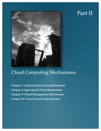
Technology mechanisms represent well-defined IT artifacts that are established within an IT industry and commonly distinct to a certain computing model or platform. The technology-centric nature of cloud computing requires the establishment of a formal level of mechanisms to be able to explore how solutions can be assembled via different combinations of mechanism implementations. These chapters formally documents twenty technology mechanisms that are used within cloud environments to enable generic and specialized forms of functionality. Each mechanism description is accompanied by a case study example that demonstrates its usage. The utilization of the mechanisms is further explored throughout the technology architectures covered in Part III.
Chapter 7: Cloud Infrastructure Mechanisms
Chapter 8: Specialized Cloud Mechanisms
Chapter 9: Cloud Management Mechanisms
Chapter 10: Cloud Security Mechanisms
Chapter 7: Cloud Infrastructure Mechanisms

Technology mechanisms foundational to cloud platforms are covered, including Logical Network Perimeter, Virtual Server, Cloud Storage Device, Cloud Usage Monitor, Resource Replication, and Ready-Made Environment.
Chapter 8: Specialized Cloud Mechanisms
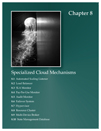 A range of specialized technology mechanisms are described, including Container, Automated Scaling Listener, Load Balancer, SLA Monitor, Pay-Per-Use Monitor, Audit Monitor, Failover System, Hypervisor, Resource Cluster, Multi-Device Broker, and State Management Database.
A range of specialized technology mechanisms are described, including Container, Automated Scaling Listener, Load Balancer, SLA Monitor, Pay-Per-Use Monitor, Audit Monitor, Failover System, Hypervisor, Resource Cluster, Multi-Device Broker, and State Management Database.
Chapter 9: Cloud Management Mechanisms
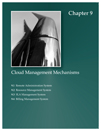
Mechanisms that enable the hands-on administration and management of cloud-based IT resources are explained, including Remote Administration System, Resource Management System, SLA Management System, and Billing Management System.
Chapter 10: Cloud Security Mechanisms
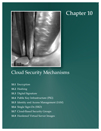
Security mechanisms that can be used to counter and prevent the threats described in Chapter 6 are covered, including Encryption, Hashing, Digital Signatures, Public Key Infrastructures (PKI), Identity and Access Management (IAM) Systems, Single Sign-On (SSO), Cloud-based Security Groups, and Hardened Virtual Server Images.
Part III: Cloud Computing Architecture
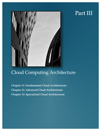
Technology architecture within the realm of cloud computing introduces requirements and considerations that manifest themselves in broadly scoped architectural layers and numerous distinct architectural models. This set of chapters builds upon the coverage of cloud computing mechanisms from Part II by formally documenting twenty-nine cloud-based technology architectures and scenarios in which different combinations of the mechanisms are documented in relation to fundamental, advanced, and specialized cloud architectures.
Chapter 11: Fundamental Cloud Architectures
Chapter 12: Advanced Cloud Architectures
Chapter 13: Specialized Cloud Architectures
Chapter 11: Fundamental Cloud Architecture
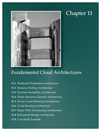 Fundamental cloud architectural models establish baseline functions and capabilities. The architectures covered in this chapter are Workload Distribution, Resource Pooling, Dynamic Scalability, Elastic Resource Capacity, Service Load Balancing, Cloud Bursting, Elastic Disk Provisioning, and Redundant Storage.
Fundamental cloud architectural models establish baseline functions and capabilities. The architectures covered in this chapter are Workload Distribution, Resource Pooling, Dynamic Scalability, Elastic Resource Capacity, Service Load Balancing, Cloud Bursting, Elastic Disk Provisioning, and Redundant Storage.
Chapter 12: Advanced Cloud Architecture
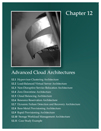 Advanced cloud architectural models establish sophisticated and complex environments, several of which directly build upon fundamental models. The architectures covered in this chapter are Hypervisor Clustering, Load-Balanced Virtual Server, Non-Disruptive Service Relocation, Zero Downtime, Cloud Balancing, Resource Reservation, Dynamic Failure Detection and Recovery, Bare-Metal Provisioning, Rapid Provisioning, and Storage Workload Management.
Advanced cloud architectural models establish sophisticated and complex environments, several of which directly build upon fundamental models. The architectures covered in this chapter are Hypervisor Clustering, Load-Balanced Virtual Server, Non-Disruptive Service Relocation, Zero Downtime, Cloud Balancing, Resource Reservation, Dynamic Failure Detection and Recovery, Bare-Metal Provisioning, Rapid Provisioning, and Storage Workload Management.
Chapter 13: Specialized Cloud Architectures
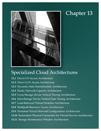 Specialized cloud architectural models address distinct functional areas. The architectures covered in this chapter are Direct I/O Access, Direct LUN Access, Dynamic Data Normalization, Elastic Network Capacity, Cross-Storage Device Vertical Tiering, Intra-Storage Device Vertical Data Tiering, Load-Balanced Virtual Switches, Multipath Resource Access, Persistent Virtual Network Configuration, Redundant Physical Connection for Virtual Servers, and Storage Maintenance Window. Note that this chapter does not contain a case study example.
Specialized cloud architectural models address distinct functional areas. The architectures covered in this chapter are Direct I/O Access, Direct LUN Access, Dynamic Data Normalization, Elastic Network Capacity, Cross-Storage Device Vertical Tiering, Intra-Storage Device Vertical Data Tiering, Load-Balanced Virtual Switches, Multipath Resource Access, Persistent Virtual Network Configuration, Redundant Physical Connection for Virtual Servers, and Storage Maintenance Window. Note that this chapter does not contain a case study example.
Part IV: Working with Clouds
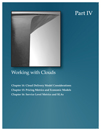
Cloud computing technologies and environments can be adopted to varying extents. An organization can migrate select IT resources to a cloud, while keeping all other IT resources on-premise – or – it can form significant dependencies on a cloud platform by migrating larger amounts of IT resource or even using the cloud environment to create them. For any organization, it is important to assess a potential adoption from a practical and business-centric perspective in order to pinpoint the most common factors that pertain to financial investments, business impact, and various legal considerations. This set of chapters explores these and other topics related to the real-world considerations of working with cloud-based environments.
Chapter 14: Cloud Delivery Model Considerations
Chapter 15: Pricing Metrics and Economic Models
Chapter 16: Service Level Metrics and SLA
Chapter 14: Cloud Delivery Model Considerations
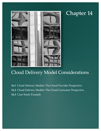 Cloud environments need to be built and evolved by cloud providers in response to cloud consumer requirements. Cloud consumers can use clouds to create or migrate IT resources to, subsequent to which they may assume administrative responsibilities. This chapter provides a technical understanding of cloud delivery models from both the provider and consumer perspectives, each of which offers revealing insights into the inner workings and architectural layers of cloud environments
Cloud environments need to be built and evolved by cloud providers in response to cloud consumer requirements. Cloud consumers can use clouds to create or migrate IT resources to, subsequent to which they may assume administrative responsibilities. This chapter provides a technical understanding of cloud delivery models from both the provider and consumer perspectives, each of which offers revealing insights into the inner workings and architectural layers of cloud environments
Chapter 15: Pricing Metrics and Economic Models
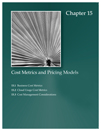 Cost metrics for network, server, storage, and software usage are described, along with various formulas for calculating integration and ownership costs related to cloud environments. The chapter concludes with a discussion of cost management topics as they relate to common business terms used by cloud provider vendors.
Cost metrics for network, server, storage, and software usage are described, along with various formulas for calculating integration and ownership costs related to cloud environments. The chapter concludes with a discussion of cost management topics as they relate to common business terms used by cloud provider vendors.
Chapter 16: Service Level Metrics and SLA
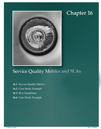 Service level agreements establish the guarantees and usage terms for cloud services and are often determined by the business terms agreed upon by cloud consumers and cloud providers. This chapter provides detailed insight into how cloud provider guarantees are expressed and structured via SLAs, along with metrics and formulas for calculating common SLA values, such as availability, reliability, performance, scalability, and resiliency.
Service level agreements establish the guarantees and usage terms for cloud services and are often determined by the business terms agreed upon by cloud consumers and cloud providers. This chapter provides detailed insight into how cloud provider guarantees are expressed and structured via SLAs, along with metrics and formulas for calculating common SLA values, such as availability, reliability, performance, scalability, and resiliency.
Part V: Appendices
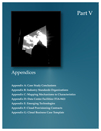
Appendix A: Case Study Conclusions
Appendix B: Industry Standards Organizations
Appendix C: Mapping Mechanisms to Characteristics
Appendix D: Data Center Facilities (TIA-942)
Appendix E: Emerging Technologies
Appendix F: Cloud Provisioning Contracts
Appendix G: Cloud Business Case Template
Appendix A: Case Study Conclusion
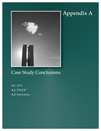
The individual storylines of the case studies are concluded and the results of each organization’s cloud computing adoption efforts are summarized.
Appendix B: Industry Standards Organizations
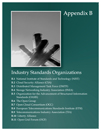
This appendix describes industry standards organizations and efforts in support of the cloud computing industry.
Appendix C: Mapping Mechanisms to Characteristics

A table is provided, mapping cloud characteristics to the cloud computing mechanisms that can help realize the characteristics.
Appendix D: Data Center Facilities (TIA-942)
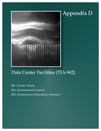
A brief overview and breakdown of common data center facilities in reference to the TIA-942 Telecommunications Infrastructure Standard for Data Centers.
Appendix E: Cloud-Adapted Risk Management Framework
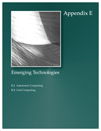 An overview of the Cloud-Adapted Risk Management Framework (CRMF) that is part of the NIST Cloud Computing Security Reference Architecture.
An overview of the Cloud-Adapted Risk Management Framework (CRMF) that is part of the NIST Cloud Computing Security Reference Architecture.
Appendix F: Cloud Provisioning Contracts
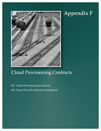 The actual agreements signed between cloud provider vendors and cloud consumer organizations are distinct legal contracts that encompass a range of specific terms and considerations. This appendix highlights the typical parts of a cloud provisioning contract, and provides further guidelines.
The actual agreements signed between cloud provider vendors and cloud consumer organizations are distinct legal contracts that encompass a range of specific terms and considerations. This appendix highlights the typical parts of a cloud provisioning contract, and provides further guidelines.
Appendix G: Cloud Business Case Template
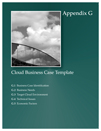 This appendix provides a checklist of items that can be used as a starting point for assembling a business case for the adoption of cloud computing.
This appendix provides a checklist of items that can be used as a starting point for assembling a business case for the adoption of cloud computing.
Appendix H: Cloud Business Case Template
